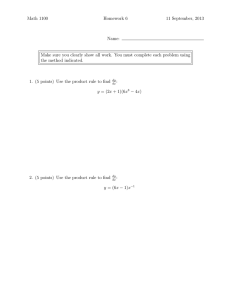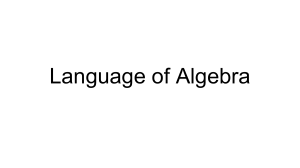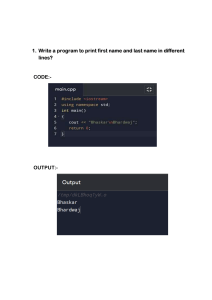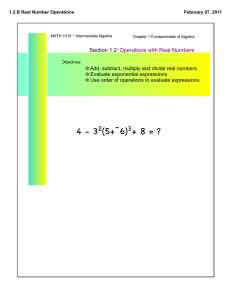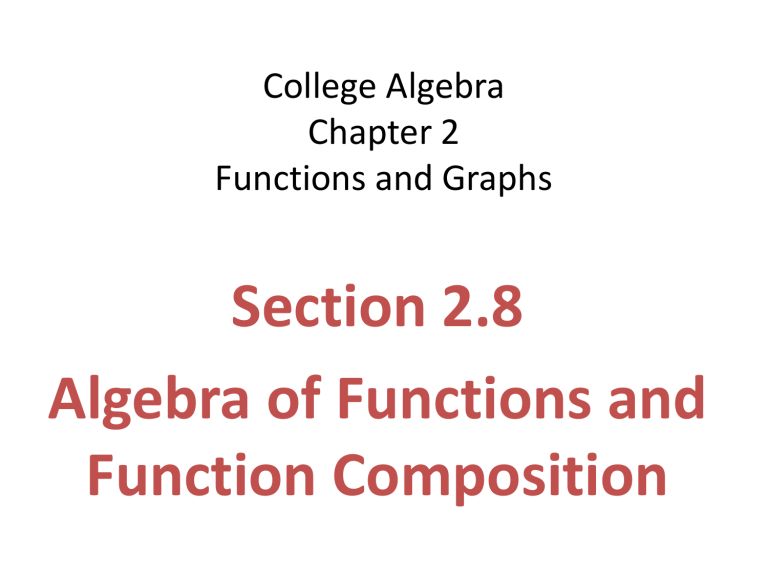
College Algebra Chapter 2 Functions and Graphs Section 2.8 Algebra of Functions and Function Composition Concepts 1. Perform Operations on Functions 2. Evaluate a Difference Quotient 3. Compose and Decompose Functions Operations on Functions Sum ( f g )( x) f ( x) g ( x) Difference ( f g )( x) f ( x) g ( x) Product ( f g )( x) f ( x) g ( x) Quotient f f ( x) provided that g ( x) 0 ( x) g ( x) g Examples 1 – 4: 2 Given f x x 3x 1, g x 8 x , h x , x 1 evaluate the function, if possible. 2 1. f 3 3. f a 1 2. g 4 4. g 10 Examples 5 – 7: 2 Given f x x 3x 1, g x 8 x , h x , x 1 evaluate the function, if possible. 2 5. f g 8 7. h 1 6. g h 0 Example 8: Evaluate and write the domain in interval notation. 2 s x x r t x t x x 4 r x x2 3 Example 9: Evaluate and write the domain in interval notation. 2 s x x r x t t x x 4 r x x2 3 Example 10: Evaluate and write the domain in interval notation. 2 s x x s t x t x x 4 r x x2 3 Concepts 1. Perform Operations on Functions 2. Evaluate a Difference Quotient 3. Compose and Decompose Functions Difference Quotient The average rate of change between P and Q is the slope of the secant line and is given by: y f ( x h) f ( x) f ( x h) f ( x) m x ( x h) x h The expression f ( x h) f ( x ) h is called the difference quotient. Example 11: f ( x h) f ( x ) Find f ( x) and for f x 5 x 2. h Example 12: f ( x h) f ( x ) Find f ( x) and for f x x 2 3 x 8. h Example 12 continued: Concepts 1. Perform Operations on Functions 2. Evaluate a Difference Quotient 3. Compose and Decompose Functions Composition of Functions The composition of f and g, denoted f is defined by ( f g )( x) f ( g ( x)) . g Example 13 continued: Given f ( x) x 3 x 1 and g ( x) 5 x 4, find 2 ( f g )( x) Example 13: Given f ( x) x 3 x 1 and g ( x) 5 x 4, find 2 ( g f )( x) Example 14: Given f ( x) 5 x 2 1 and g ( x) 5 x 5, find ( f g )( x) ( g f )( x) Example 15: 3 Given f x and g ( x) 2 x 8, find x4 ( f g )(9) ( g f )(6) Example 16: 3 Given f x and g ( x) 3 x 2, find ( f g )( x) x2 and the domain of ( f g )( x). Example 17: Given h x 3 x 7 find two functions f and g such that h( x) f g x . Example 18: Given h x x 1 8 find two functions f and g 3 such that h( x) f g x . Example 19: Estimate the function values from the graph. a. f g 3 b. g 2 f Example 19 continued: c. g f 1 d. f g 3 e. f f 3 Example 20: A party balloon is being filled with helium. As the balloon is filling, the radius of the balloon is changing at the rate of 3 inches per second. a. Write a function that represents the radius of the balloon r(t) after t seconds. b. Write a function that expresses the volume of the balloon V (r) as a function of its radius r. Example 20 continued: c. Evaluate V r t and interpret the meaning in the context of this problem. Example 20 continued: d. Evaluate V r 2 and interpret the meaning in the context of this problem.
